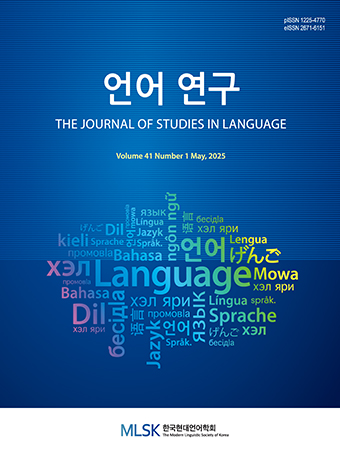Research Article
Abstract
References
Information
The purpose of this study is to confirm whether Korean students can perceive the difference in duration between singleton and geminate types of words in English and Korean and articulate distinctly. Through acoustic analyses, we want to identify the duration of geminate structures, which are categorized into two classes, tautomorphemic and concatenated, the latter subdivided into morpheme-boundary and word-boundary geminates. Thus, the current study tested some words which are associated with geminate structures and singletons on American and Korean speakers. This study showed that, concerning the Korean words, most of the Koreans who participated in the study were aware of the spelling of the words and articulated them carefully. However, with the English words, they were affected by morphemic and word boundaries without recognizing sound variations according to their specific contexts. Koreans markedly perceived the intervocalic /l/s as ambisyllabic, and there were no differences in the duration between geminates and singletons in the /l/s. In conclusion, the Koreans’ articulation deeply relied on the spelling of words and was greatly affected by their mother languages’ speech sound system.
- Balongné, B. K. 2001. Ambisyllabicity across word boundaries: A Strict CV Phonology approach. DOXIMP 6, 1-8.
- Borowsky, T. 1987. Topics in the lexical phonology of English. Doctoral dissertation. University of Massachusetts.
- Borowsky, T., J. Itô, and R. A. Mester. 1984. The formal representation of ambisyllabicity: Evidence from Danish. In NELS 14, 34-48.
- Davis. S. 2003. The controversy over geminates and syllable weight. In Féry and van de Vijver (eds.). The Syllable in optimality theory, 77-98. 10.1017/CBO9780511497926.004
- Delattre, P. 1968. The General Phonetic Characteristics of Languages (final report, 1967-1968). Santa Barbara: US Office of Education and the University of California, Santa Barbara.
- Fallow, D. 1981. Experimental evidence for English syllabification and syllable structure. Journal of Linguistics 17.02, 309-317. 10.1017/S0022226700007027
- Gussmann, E. 2002. Phonology: analysis and theory. Cambridge University Press. 10.1017/CBO9781139164108
- Hammond, M. 1999. The phonology of English: A prosodic optimality-theoretic approach. Oxford: Oxford University Press.
- Harris, J. 1994. English sound structure. Oxford: Blackwell.
- Hayes, B. 1989. Compensatory lengthening in moraic phonology. Linguistic Inquiry, 20.2, 253-306.
- Jensen, J. T. 1993. English phonology. Amsterdam: Benjamins. 10.1075/cilt.99 8319648 PMC1567018
- Johnson, K. 2003. Acoustic and auditory phonetics: second edition. Oxford: Blackwell.
- Kaye, A. S. 2005. Gemination in English. English Today 21.02, 43-55. 10.1017/S0266078405002063
- Kenyon, J. S. and T. A. Knott. 1953. A Pronouncing Dictionary of American English. Springfield, MA: G. & C. Merriam Co.
- Kim-Renaud, Y. K. 1974. Korean consonantal phonology. Honolulu: Hawaii.
- Kreidler, C. W. 2004. The Pronunciation of English. Oxford: Blackwell. 10.1002/9780470759264
- Ladefoged, P. 2006. A course in phonetics (2nd ed). New York: Harcourt Brace Jovanovich.
- Lane, L. 2013. Focus on pronunciation 3, (3rd ed). New York: Pearson Education, Inc.
- Leben, W. R. 1980. A metrical analysis of length. Linguistic Inquiry 11.3, 497-509.
- Lehiste, I. 1970. Suprasegmentals. Massachusetts Inst. of Technology P.
- Malmberg, B. 1963. Phonetics. New York: Dover.
- Mohanan, K. P. 1986. The theory of lexical phonology. Dordrecht: D. Reidel Publishing Company.
- Oh, G. E. and M. A. Redford. 2012. The production and phonetic representation of fake geminates in English. Journal of Phonetics 40.1, 82-91. 10.1016/j.wocn.2011.08.003 22611293 PMC3352589
- Oh, K. Y. 2013. Analysis of the Implication Relation between Syllabification and Phonetic Realization in Korean Speakers. The Linguistic Association of Korea Journal 21.4, 265-282.
- Oh, K. Y. 2014. A Phonological Approach to the Contextual Variances of the English Lateral /l/. English21 27.3, 363-385. 10.35771/engdoi.2014.27.3.017
- Oh, K. Y. 2015. An Analysis of Gemination and Degemination in English. English Language & Literature Teaching 21.3, 133-150.
- Oh, K. Y. 2016. A Study of the Distributions and Realizations of Variants in the English Voiceless Alveolar Stop. Studies in English Language & Literature 42.2, 213-237. 10.21559/aellk.2016.42.2.011
- Oh, K. Y. 2016. Prosodic Approaches to Ambisyllabic Consonants in English. Lingua Humanitatis 18, 263-287. 10.16945/201618111
- Pulgram, E. 1970. Syllable, Word, Nexus, Cursus. The Hague: Mouton. 10.1515/9783110815443
- Ridouane, R. 2010. Geminates at the junction of phonetics and phonology. Papers in laboratory phonology X, 61-90. Berlin: Mouton de Gruyter.
- Selkirk, E. O. 1990. A two-root theory of length. University of Massachusetts Occasional Papers 14, 123-171.
- Shin, S. H. and Y. Hwang. 2012. Perception and production of English geminate consonants across word boundaries by Korean learners and native speakers of English. Studies in Phonetics, Phonology and Morphology 18.1, 85-110. 10.17959/sppm.2012.18.1.85
- Stonham, J. 2009. Introduction to phonology. Seoul: HanKukMunhwasa.
- Suh, C. K. 2006. Stress, gemination and ambisyllabicity in English. Studies in Phonetics, Phonology and Morphology 12.3, 563-576.
- Yavaş, M. 2011. Applied English phonology. Malden, MA: Blackwell Publishers. 10.1002/9781444392623
- Publisher :The Modern Linguistic Society of Korea
- Publisher(Ko) :한국현대언어학회
- Journal Title :The Journal of Studies in Language
- Journal Title(Ko) :언어연구
- Volume : 36
- No :3
- Pages :373-395
- DOI :https://doi.org/10.18627/jslg.36.3.202011.373




 The Journal of Studies in Language
The Journal of Studies in Language






